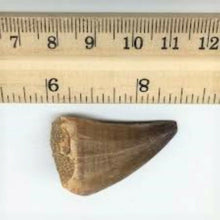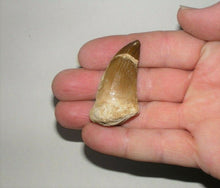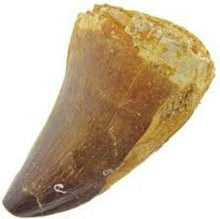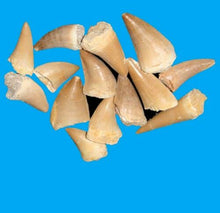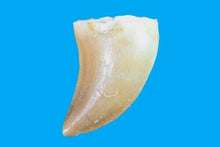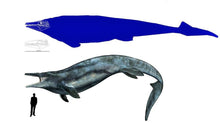
Mosasaur Tooth, Prehistoric Marine Reptile, Genuine Tooth, Upper Cretaceous, Worldwide Shipping
For sale is a Mosasaur tooth. The Mosasaur was a very large prehistoric marine reptile that is believed to be the ancestor of modern day lizards. It is estimated to have been between 50 feet – 70 feet long. Mosasaurs lived during the cretaceous period. This tooth originates from Morocco.
- The tooth itself measures about 1-1.25 inches long (2.5 to 3.2 cm) long and may differ slightly from what is pictured in the photos.
- A tooth will be selected at random from the lot pictured.
(from thought co):
Name:
Mosasaurus (Greek for "Meuse lizard"); pronounced MOE-zah-SORE-us
Habitat:
Oceans worldwide
Historical Period:
Late Cretaceous (70-65 million years ago)
Size and Weight:
About 50 feet long and 15 tons
Diet:
Fish, squids, and shellfish
Distinguishing Characteristics:
Enormous size; blunt, alligator-like head; fin on end of tail; hydrodynamic build
About Mosasaurus
The remains of Mosasaurus were discovered well before educated society knew anything about evolution, dinosaurs, or marine reptiles—in a mine in Holland in the late 18th century (hence this creature's name, in honor of the nearby Meuse river). Importantly, the unearthing of these fossils led early naturalists like Georges Cuvier to speculate, for the first time, about the possibility of species going extinct, which flew in the face of accepted religious dogma of the time. (Until the late Enlightenment, most educated people believed that God created all the world's animals in Biblical times, and the exact same animals existed 5,000 years ago as do today. Did we mention that they also had no conception of deep geologic time?) These fossils were variously interpreted as belonging to fish, whales and even crocodiles; the closest guess, by the Dutch naturalist Aadrian Camper, was that they were giant monitor lizards!
It was Georges Cuvier who established that the fearsome, 50-foot-long Mosasaurus was a giant member of the family of marine reptiles known as mosasaurs, which were characterized by their large heads, powerful jaws, streamlined bodies and hydrodynamic front and rear flippers. Mosasaurs were only distantly related to the pliosaurs and plesiosaurs that preceded them (and which they largely supplanted from dominance of the world's oceans during the late Cretaceous period), today, evolutionary biologists believe they were most closely related to modern-day snakes and monitor lizards. The mosasaurs themselves went extinct 65 million years ago, along with their dinosaur and pterosaur cousins, by which time they may already have been succumbing to competition from better-adapted sharks.
As with many animals that have lent their names to entire families, we know comparatively less about Mosasaurus than we do about better-attested mosasaurs like Plotosaurus and Tylosaurus. The early confusion about this marine reptile is reflected in the various genera to which it was assigned in the course of the 19th century, including (take a deep breath) Batrachiosaurus, Batrachotherium, Drepanodon, Lesticodus, Baseodon, Nectoportheus and Pterycollosaurus. There have also been close to 20 named species of Mosasaurus, which gradually fell by the wayside as their fossil specimens were assigned to other mosasaur genera; today, all that remain are the type species, M. hoffmanni, and four others.
By the way, that shark-swallowing Mosasaurus in Jurassic World may seem impressive (both to people in the fictional park and people in the real-life movie-theater audience), but it's completely out of scale: a real, 15-ton Mosasaurus would have been an order of magnitude smaller and much less impressive than its cinematic depiction—and almost certainly incapable of dragging a gigantic Indominus rex into the water!
THE ITEM(S) WILL BE SHIPPED OUT VIA STANDARD MAIL (INTERNATIONAL REGISTERED MAIL) (ESTIMATED SHIPPING TIME IS APPROXIMATELY 10-15 WORKING DAYS DEPENDING ON COUNTRY AND LOCATION). THANK YOU FOR LOOKING.







